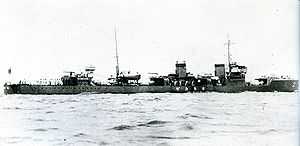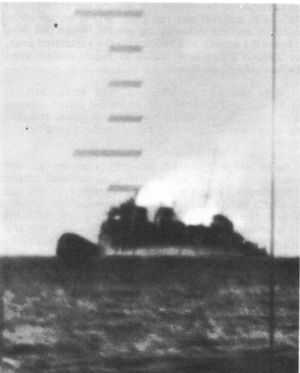Japanese destroyer Okikaze
 Okikaze at Yokosuka, 1932 | |
| Career | |
|---|---|
| Name: | Okikaze |
| Ordered: | fiscal 1917 |
| Builder: | Maizuru Naval Arsenal |
| Laid down: | February 22, 1919 |
| Launched: | October 3, 1919 |
| Commissioned: | August 17, 1920 |
| Struck: | March 1, 1944 |
| Fate: | Sunk in action, January 10, 1943 |
| General characteristics | |
| Class and type: | Minekaze-class destroyer |
| Displacement: | 1,345 long tons (1,367 t) normal, 1,650 long tons (1,680 t) full load |
| Length: | 97.5 m (320 ft) pp, 102.6 m (337 ft) overall |
| Beam: | 9 m (30 ft) |
| Draught: | 2.8 m (9.2 ft) |
| Propulsion: | 2-shaft Mitsubishi-Parsons geared turbines, 4 boilers 38,500 ihp (28,700 kW) |
| Speed: | 39 knots (72 km/h) |
| Range: | 3600 nm @ 14 knots (6,700 km at 26 km/h) |
| Complement: | 148 |
| Armament: | 4 × Type 3 120 mm 45 caliber naval gun 6 × 21 in (533 mm) torpedo tubes 2 × 7.7 mm machine guns |
| Service record | |
|---|---|
| Operations: |
Second Sino-Japanese War Pacific War |

Okikaze (沖風 Offshore Wind)[1] was a Minekaze-class destroyer, built for the Imperial Japanese Navy immediately following World War I. Advanced for their time, these ships served as first-line destroyers through the 1930s, but were considered obsolescent by the start of the Pacific War.
History
Construction of the large-sized Minekaze-class destroyers was authorized as part of the Imperial Japanese Navy's 8-4 Fleet Program from fiscal 1917–1920, as an accompaniment to the medium-sized Momi class, with which they shared many common design characteristics.[2] Equipped with powerful engines, these vessels were capable of high speeds and were intended as escorts for the projected Amagi-class battlecruisers, which were ultimately never built.[3] Okikaze, built at the Maizuru Naval Arsenal, was the third ship of this class. It was laid down on February 22, 1919, launched on October 3, 1919 and commissioned on August 17, 1920.[4]
On completion, Okikaze was teamed with sister ships Minekaze, Sawakaze, and Yakaze at the Sasebo Naval District to form Destroyer Division 2 under the IJN 2nd Fleet.
From 1930-1932, Destroyer Division 2 was reassigned to the IJN 1st Air Fleet as part of the escort of the aircraft carrier Akagi, to assist in search and rescue operations for downed aircraft.
At the time of the First Shanghai incident of 1932, Okikaze was engaged in river patrol duties along the Yangzi River in China.
World War II history
At the time of the attack on Pearl Harbor, Okikaze was based at the Ōminato Guard District in northern Japan, and was assigned to patrols of the Tsugaru Strait and the coastline of southern Hokkaidō.
In April 1942, Okikaze was recalled to the Yokosuka Naval District, where it was assigned anti-submarine patrols of the entrance of Tokyo Bay for the duration of the war, making only an occasional convoy escort run along the coast of Japan to Kushimoto, Wakayama or patrols of the coast of northern Honshū through the end of 1942.
On January 10, 1943, Okikaze was torpedoed by the submarine USS Trigger just 35 miles (56 km) southeast of Yokosuka, within sight of Katsura Lighthouse, 35°02′N 140°12′E / 35.033°N 140.200°ECoordinates: 35°02′N 140°12′E / 35.033°N 140.200°E. One torpedo hit under the well deck and folded the destroyer's forecastle up at a 45° angle, and another hit Okikaze 's stern. The ship sank with the loss of most crewmen, including its captain.[5]
However, Okikaze was not officially removed from navy list until March 1, 1944.[6]
References
- Brown, David (1990). Warship Losses of World War Two. Naval Institute Press. ISBN 1-55750-914-X.
- Howarth, Stephen (1983). The Fighting Ships of the Rising Sun: The Drama of the Imperial Japanese Navy, 1895–1945. Atheneum. ISBN 0-689-11402-8.
- Jentsura, Hansgeorg (1976). Warships of the Imperial Japanese Navy, 1869–1945. US Naval Institute Press. ISBN 0-87021-893-X.
- Nelson, Andrew N. (1967). Japanese–English Character Dictionary. Tuttle. ISBN 0-8048-0408-7.
- Watts, Anthony J (1967). Japanese Warships of World War II. Doubleday. ASIN B000KEV3J8.
- Whitley, M J (2000). Destroyers of World War Two: An International Encyclopedia. London: Arms and Armour Press. ISBN 1-85409-521-8.
External links
- Nevitt, Allyn D. (1997). "IJN Okikaze: Tabular Record of Movement". Long Lancers. Combinedfleet.com.
- Nishidah, Hiroshi (2002). "Minekaze class 1st class destroyers". Materials of the Imperial Japanese Navy.
- Jones, Daniel H. (2003). "IJN Minekaze, Kamikaze and Mutsuki class Destroyers". Ship Modeler's Mailing List (SMML).
Notes
- ↑ Nelson. Japanese-English Character Dictionary. pages 537, 960
- ↑ Howarth, The Fighting Ships of the Rising Sun.
- ↑ Globalsecurity.org, IJN Minekaze class destroyers.
- ↑ Nishidah, Hiroshi (2002). "Minekaze class 1st class destroyers". Materials of the Imperial Japanese Navy.
- ↑ Nevitt, Allyn D. (1997). "IJN Okikaze: Tabular Record of Movement". Long Lancers. Combinedfleet.com.
- ↑ Nishidah, Hiroshi (2002). "Minekaze class 1st class destroyers". Materials of the Imperial Japanese Navy.
| ||||||||||||||||||||||||||||||||